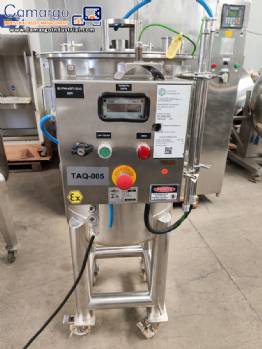Explosion-proof (EX-rated) mixing reactor tanks are essential equipment in various industries that handle flammable or hazardous substances. Let's take a closer look at how they work, what they are used for, the types and industries that use them:
1. What is an explosion-proof (EX) mixing reactor tank?
An EX explosion-proof mixing reactor tank is a type of industrial processing equipment designed to ensure safety in environments where there is a risk of explosions due to the presence of flammable vapors, gases or dusts. The EX rating is associated with compliance with international safety standards, such as ATEX (European) and NEC (National Electric Code) (American), which specify explosion protection requirements.
These tanks combine two main functions:
Mixer: They mix different substances (liquids or gases) to ensure adequate homogenization.
Reactor: They carry out controlled chemical reactions between the mixed components.
2. What is an EX mixing reactor tank used for?
These tanks are used for:
Mixing substances: Many industries require a precise mixture of liquids, solids and gases to produce chemical, pharmaceutical, food and other products.
Controlled chemical reactions: Many chemical reactions, such as those used to manufacture industrial chemicals, need to occur under specific temperature, pressure and mixing conditions.
Safety in hazardous environments: The EX classification ensures that the equipment is capable of operating safely in explosive atmospheres, preventing accidental ignitions that could lead to explosions.
3. How does an EX mixing reactor tank work?
These tanks have several safety features:
Explosion-proof construction: The tank structure is designed to withstand internal pressures and prevent ignition due to sparks or high temperatures.
Explosion-proof components and materials: Motors, valves, seals and other components are made of specific materials that prevent the generation of sparks or overheating.
Venting and pressure relief systems: To ensure that flammable gases or vapors do not build up inside the tank, they have venting systems or relief valves.
Temperature and pressure monitoring: Temperature and pressure sensors are used to monitor the conditions inside the tank, preventing chemical reactions from getting out of control.
4. What are the types of EX mixing reactor tanks?
There are several types of EX mixing reactor tanks, including:
Stirred reactor tanks: These use an agitator (or mixer) to keep the substances in motion during the reaction or mixing process.
Fixed and fluid bed reactor tanks: Depending on the process, the tank may have a fixed bed (where the reactants are stationary) or a fluid bed (where the particles are in motion).
High pressure reactor tanks: For reactions that require high pressure.
Low temperature or cryogenic reactor tanks: For reactions that occur at extremely low temperatures.
5. What industries use EX mixing reactor tanks?
Industries that handle chemicals, pharmaceuticals, food, petrochemicals, or any type of flammable or explosive material use these tanks. Some examples include:
Chemical industry: Production of chemicals such as solvents, acids, and fertilizers.
Pharmaceutical industry: Production of medicines and sensitive chemicals.
Petrochemical industry: Processing of gas, oil, and other derivative products.
Food and beverage industry: Processing of ingredients such as oils, dyes, and food additives.
Cosmetics industry: Mixing of substances for cosmetics and personal care products.
6. What products use EX mixing reactor tanks?
The products that use these tanks vary widely, but some examples include:
Industrial chemicals: Acids, solvents, paints and varnishes, detergents, fertilizers.
Drugs: Active ingredients in drugs, such as those used in liquid or suspension forms.
Food and beverages: Blends for the production of soft drinks, syrups, oils, seasonings, and other food products.
Cosmetics and personal care: Lotions, shampoos, creams, deodorants, and other products.
Petrochemicals: Fuels, plastics, rubbers, and other petroleum products.
7. EX Regulations and Certification:
EX certification follows safety standards to ensure that equipment does not cause ignition in hazardous atmospheres. Key regulations include:
ATEX (Europe) – Directive 2014/34/EU, which specifies safety requirements for equipment used in explosive atmospheres.
NEC 500/505 (USA) – Electrical safety standards for equipment in hazardous areas.
IECEx (Integrated nacional) – Global certification system for electrical equipment in hazardous areas.
Conclusion
EX mixing reactor tanks are essential to ensure safety in industrial environments where there is a risk of explosion due to flammable substances or chemical reactions. They are widely used in chemical, pharmaceutical, food, cosmetics, and petrochemical industries, where the safety and efficiency of reactions or mixing are critical. The EX classification ensures that these equipment meet strict safety standards to prevent accidents and protect workers and the environment.
EX reactor mixing tanks are essential for ensuring safety in industrial environments where there is a risk of explosion due to flammable substances or chemical reactions. They are widely used in the chemical, pharmaceutical, food, cosmetics and petrochemical industries, where the safety and efficiency of reactions or mixing are critical. The EX classification ensures that these equipment meet strict safety standards to prevent accidents and protect workers and the environment.
ATEX, NEC 500/505 and IECEx classifications are internationally recognized safety standards for equipment used in potentially explosive atmospheres. Each of these systems has its own criteria and requirements to ensure that the equipment can be used safely in areas at risk of explosion.
Here is a detailed look at the classification levels and types of each of these systems:
1. ATEX Classification (European Union)
ATEX classification is regulated by the European Union Directive 2014/34/EU, which defines the requirements for equipment used in areas with explosive atmospheres. ATEX has two main components:
ATEX 95: Requirements for equipment.
ATEX 137: Requirements for zones and safety in the workplace.
ATEX Classification for Equipment:
Equipment is classified based on equipment group, category and zone.
1.1. Equipment Groups:
Group I: Equipment for use in mines, with a risk of explosive atmospheres due to the presence of methane gas or dust.
Group II: Equipment for use in other industrial areas, with a risk of explosive atmospheres due to the presence of flammable gases, vapors or mists (not related to mines).
1.2. Equipment Categories: The categories indicate the safety level of the equipment in relation to the risk of explosion. For Group II (general industries):
Category 1: High safety level equipment. Can be used in constant or very frequent explosive atmospheres.
Category 2: Medium safety level equipment. Can be used in occasional explosive atmospheres.
Category 3: Basic safety level equipment. Can be used in rare explosive atmospheres.
1.3. Explosive Atmosphere Zones:
Zone 0: Environment where the explosive atmosphere is present continuously or for long periods.
Zone 1: Explosive atmosphere may occur occasionally during normal operation.
Zone 2: Explosive atmosphere does not occur under normal conditions, but may occur for short periods.
ATEX classification for equipment protection:
Equipment protection is also classified based on different types of safety measures, such as:
Ex d: Equipment with safety enclosure to prevent internal ignitions.
Ex e: Equipment with additional protection to prevent overheating.
Ex i: Equipment with low energy to prevent sparks or discharges.
2. NEC 500/505 classification (National Electrical Code - USA)
NEC 500/505 deals with the installation of electrical equipment in classified areas in the USA. This classification uses the concept of zones and gas groups and is closely related to electrical protection in locations where there is a risk of explosion.
Area Classification (Zones):
Zone 0: Explosive atmosphere is present continuously or for long periods.
Zone 1: Explosive atmosphere may occur during normal operation.
Zone 2: Explosive atmosphere does not occur normally, but may occur intermittently.
Gas Group Classification:
Group I: Atmospheres with methane gas (underground mines).
Group II: Equipment used in industrial areas with a risk of flammable gases or vapors.
Group III: Equipment used in areas with combustible dusts.
Temperature Classification:
Equipment also has a temperature classification to ensure that it does not reach temperatures capable of causing ignition.
T1: Maximum temperature of 450°C.
T2: Maximum temperature of 300°C.
T3: Maximum temperature of 200°C.
T4: Maximum temperature of 135°C.
T5: Maximum temperature of 100°C.
T6: Maximum temperature of 85°C.
3. IECEx Classification (International)
IECEx is a global certification system for equipment used in explosive atmospheres. It follows the IEC 60079 standard and is designed to facilitate the trade of safe equipment for hazardous areas between different countries.
IECEx classification of equipment:
The IECEx classification is similar to ATEX and uses the same approach in terms of groups, zones and protection.
3.1. Equipment groups:
Group I: Equipment for use in mining.
Group II: Equipment for use in other industrial areas.
3.2. Equipment categories (similar to ATEX):
Ex ia: Equipment with a high level of safety (proven not to cause ignition).
Ex ib: Equipment with a medium level of safety.
Ex n: Equipment with basic protection (does not generate sparks or overheat).
3.3. Equipment Protection Classification:
Ex d: Safety enclosure.
Ex e: Additional protection.
Ex i: Low energy protection.
Classification Summary:
System Zones Groups Protection Levels
ATEX Zone 0, 1, 2 Group I (mining), Group II (industry) Ex d, Ex e, Ex i, etc.
NEC 500/505 Zone 0, 1, 2 Group I (methane), Group II (gases), Group III (dusts) Temperature classification (T1-T6)
IECEx Similar to ATEX: Zone 0, 1, 2 Group I, Group II Ex ia, Ex ib, Ex d, Ex e, Ex i
Conclusion
ATEX is the European system, focusing on equipment safety and hazardous areas.
NEC 500/505 is the US system, with an emphasis on electrical safety and hazardous areas.
IECEx is an international system that facilitates the global certification of equipment for hazardous areas.
These systems are essential to ensure safety in industries and facilities that operate in environments with a risk of explosions, such as chemical, petrochemical, pharmaceutical, and food industries, among others. |




